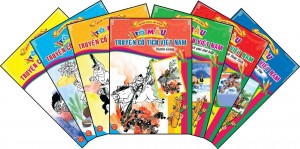The folk literature has been developed for centuries with many arts, including a typical 6–8 verse poem kind named “ca dao”
Since coming into existence, Vietnamese literature has been rich in folklore and proverbs; tales that have been handed down from generation to generation, gradually becoming valuable treasures. New literary movements can usually be observed every ten years but in the last century, Vietnamese literature underwent several literary transitions.
The folk literature has been developed for centuries with many arts, including a typical 6–8 verse poem kind named “ca dao”, a system of tales about village establishers and heroes which served as cultural base for many cultural regions.

A revolutionary campaign occurred at the beginning of Romanized Vietnamese literature, in an attempt to standardize its styles such as prose, poetry, and criticism. All the writings produced had one thing in common: the authors were using a powerful and flexible style to update events and trends and therefore predict social events.
For more than a half century the Vietnamese people fought two wars of resistance, and at the present time, are in a period of construction, industrialization and modernization. In this situation, in Vietnamese literature, movement and vital force currently exist.

Vietnamese literature, both oral and written, created largely by Vietnamese-speaking people, although Francophone Vietnamese and English-speaking Vietnamese authors in Australia and the United States are counted by many critics as part of the national tradition. For much of its history, Vietnam was dominated by China and as a result much of the written work during this period was in Classical Chinese. Chu nom, created around the 10th century, allowed writers to compose in Vietnamese using modified Chinese characters. Although regarded as inferior to Chinese, it gradually grew in prestige. It flourished in the 18th century when many notable Vietnamese writers and poets composed their works in Chu nom and when it briefly became the official written script.
While the quoc ngu script was created in the 17th century, it did not become popular outside of missionary groups until the early 20th century, when the French colonial administration mandated its use in French Indochina. By the mid-20th century, virtually all Vietnamese works of literature were composed in quoc ngu
Some defining works of literature include The Tale of Kieu by Nguyen Du, and Lục Van Tien by Nguyen Dinh Chieu.
In Vietnamese modern prose, there were authors who could emulate whomever in the world, namely, Nguyen Cong Hoan, Vu Trong Phung, Ngô Tất Tố, Nguyen Hong, Nguyen Tuan and Nam Cao. They were joined by excellent poets: Xuan Dieu, Huy Can, Han Mac Tu, and Nguyen Binh. Regrettably, their great works that faithfully reflected the country and the times have yet to appear.
Poetry
Legendary female poetess Ho Xuan Huong (born during the end of the 18th century) composed much of her poetry in Chu Nom, and most of it has been translated into quoc ngu for modern Vietnamese. Her poetry continues to be widely popular. Other poets such as the famous Mandarin official Duong Khue had some of his poetry adapted into songs that are still famous today, such as the Ca tru-genre song “hong hong tuyet tuyet”.
Many Vietnamese poems, along with folk “literature” in general, tends to be much more of an oral tradition – as literacy (as it is defined today) in the past was restricted mostly to scholars and the elite
Source: customvietnamtravel
